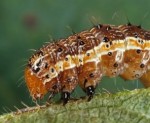 The fall army worm is the caterpillar of a moth. It is native to the tropical regions of the western hemisphere from the United States to Argentina but overwinters in the United States only in southern Florida and southern Texas. During the summer months the moths fly northward for hundreds of miles and lay their eggs in most regions of the United States east of the Rocky Mountains. They are serious pests in the southeastern states where the caterpillars feed on all types of grains and legumes, corn, cucumbers, tomatoes, and cabbage. They can also be a serious threat to lawns.
The fall army worm is the caterpillar of a moth. It is native to the tropical regions of the western hemisphere from the United States to Argentina but overwinters in the United States only in southern Florida and southern Texas. During the summer months the moths fly northward for hundreds of miles and lay their eggs in most regions of the United States east of the Rocky Mountains. They are serious pests in the southeastern states where the caterpillars feed on all types of grains and legumes, corn, cucumbers, tomatoes, and cabbage. They can also be a serious threat to lawns.

 Description: The caterpillars are 1½ to 2 inches long and have brownish or greenish bodies marked with white lines on its back and sides. An inverted white “Y” on its head distinguishes it from other similar caterpillars. Caterpillars feed both night and day for about 14 days but tend to be most active in the morning and evening, avoiding the brightest part of the day. Adult moths have a wing span of about 1½ inches, have a grayish brown forewing and iridescent silver-white hind wing with a narrow dark border. They are nocturnal and prefer warm, humid conditions. Females lay up to two thousand pale gray eggs covered by fuzzy scales in masses of fifty to several hundred. After two to three days the larva emerge and begin their two to three week feeding period after which they pupate in the soil for about two weeks in warm weather, up to thirty days in cool weather.
Description: The caterpillars are 1½ to 2 inches long and have brownish or greenish bodies marked with white lines on its back and sides. An inverted white “Y” on its head distinguishes it from other similar caterpillars. Caterpillars feed both night and day for about 14 days but tend to be most active in the morning and evening, avoiding the brightest part of the day. Adult moths have a wing span of about 1½ inches, have a grayish brown forewing and iridescent silver-white hind wing with a narrow dark border. They are nocturnal and prefer warm, humid conditions. Females lay up to two thousand pale gray eggs covered by fuzzy scales in masses of fifty to several hundred. After two to three days the larva emerge and begin their two to three week feeding period after which they pupate in the soil for about two weeks in warm weather, up to thirty days in cool weather.
 Control: For small infestations, handpick the caterpillars during the day or night. Severe outbreaks can be treated with Bacillus thuringiensis if done early, soon after the worms have begun to feed. Insecticides containing carbyl (Sevin), or malathion can be used when necessary.
Control: For small infestations, handpick the caterpillars during the day or night. Severe outbreaks can be treated with Bacillus thuringiensis if done early, soon after the worms have begun to feed. Insecticides containing carbyl (Sevin), or malathion can be used when necessary.

Photos from Wikipedia